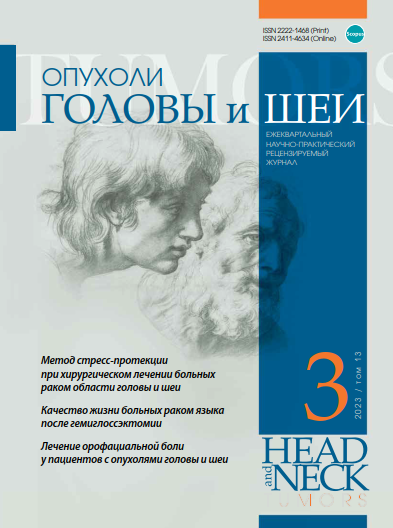Intra-tumoral molecular heterogeneity of grade 3 astrocytomas and oligodendrogliomas and its significance in disease prognosis
- Authors: Nikitin P.V.1, Belyaev A.Y.2, Musina G.R.3, Kobyakov G.L.2, Pronin I.N.2, Usachev D.Y.2
-
Affiliations:
- University of Houston
- N.N. Burdenko National Medical Research Center of Neurosurgery, of the Ministry of Health of Russia
- Baylor Medical College
- Issue: Vol 13, No 3 (2023)
- Pages: 51-62
- Section: ORIGINAL REPORT
- Published: 11.12.2023
- URL: https://ogsh.abvpress.ru/jour/article/view/914
- DOI: https://doi.org/10.17650/2222-1468-2023-13-3-51-62
- ID: 914
Cite item
Full Text
Abstract
Introduction. Malignant brain tumors, such as anaplastic astrocytomas and anaplastic oligodendrogliomas grade 3, are characterized by high aggressiveness and pose a serious clinical problem. This study focuses on assessing intratumoral heterogeneity in anaplastic astrocytomas and anaplastic oligodendrogliomas and its impact on disease prognosis.
Aim. To study characteristics of intratumoral heterogeneity, in particular such morphological criteria as necrosis, vascular proliferation, mitoses, and mutations in the most significant for glioma progression genes in the groups of grade III astrocytomas and oligodendrogliomas, as well as analysis of prognostic significance of these parameters.
Materials and methods. The study included 389 patients with IDH-mutant astrocytomas and 200 patients with oligodendrogliomas. The mean Ki-67 labeling index of astrocytomas was 12.78 %, while that of oligodendrogliomas was 8.54 %.
Results. The presence of vascular proliferation, necrosis, of more than 20 % of the area of the specimen occupied by sarcomatous-like areas and the number of mitoses significantly affected not only disease-free survival but also overall survival of patients. In the clinical setting, mutations in the TERT promoter gene, amplification and mutation of the EGFR gene, deletion of the CDKN2A gene, and TP53 gene had a significant negative impact on recurrence-free and overall survival.
Conclusion. The results of single-cell RNA sequencing showed additional factors, including sarcomatous-like areas, as well as TERT, EGFR, CDKN2A and TP53 mutations, in the progression of the tumors under consideration and in ensuring an increase in their malignant potential.
About the authors
P. V. Nikitin
University of Houston
Email: fake@neicon.ru
ORCID iD: 0000-0003-3223-4584
4849 Calhoun Road, Houston 77004, Texas
United StatesA. Yu. Belyaev
N.N. Burdenko National Medical Research Center of Neurosurgery, of the Ministry of Health of Russia
Author for correspondence.
Email: belyaev@nsi.ru
ORCID iD: 0000-0002-2337-6495
Sergey A. Lukyanov
16, 4th Tverskaya-Yamskaya, Moscow 125047
Russian FederationG. R. Musina
Baylor Medical College
Email: fake@neicon.ru
ORCID iD: 0000-0002-9962-0909
3; 1 Baylor Plaza, Houston 77030, Texas
United StatesG. L. Kobyakov
N.N. Burdenko National Medical Research Center of Neurosurgery, of the Ministry of Health of Russia
Email: fake@neicon.ru
ORCID iD: 0000-0002-7651-4214
16, 4th Tverskaya-Yamskaya, Moscow 125047
Russian FederationI. N. Pronin
N.N. Burdenko National Medical Research Center of Neurosurgery, of the Ministry of Health of Russia
Email: fake@neicon.ru
ORCID iD: 0000-0002-4480-0275
16, 4th Tverskaya-Yamskaya, Moscow 125047
Russian FederationD. Yu. Usachev
N.N. Burdenko National Medical Research Center of Neurosurgery, of the Ministry of Health of Russia
Email: fake@neicon.ru
ORCID iD: 0000-0002-8924-7346
16, 4th Tverskaya-Yamskaya, Moscow 125047
Russian FederationReferences
- Louis D.N., Perry A., Reifenberger G., von Deimling A. et al. The 2016 World Health Organization classification of tumors of the central nervous system: a summary. Acta Neuropathologica 2016;131(6):803–20. doi: 10.1007/s00401-016-1545-1
- Cardiff R.D., Miller C.H., Munn R.J. Manual hematoxylin and eosin staining of mouse tissue sections. Cold Spring Harbor Protocols 2014;2014(6):655–8. doi: 10.1101/pdb.prot073411
- Nikitin P.V., Musina G.R., Pekov S.I. et al. Cell-population dynamics in diffuse gliomas during gliomagenesis and its impact on patient survival. Cancers 2022;15(1):145–64. doi: 10.3390/cancers15010145
- Ravi R.K., Walton K., Khosroheidari M. MiSeq: a next generation sequencing platform for genomic analysis. Methods Mol Biol 2018;1706:223–32. doi: 10.1007/978-1-4939-7471-9_12
- Ceccarelli M., Barthel F.P., Malta T.M. et al. Molecular profiling reveals biologically discrete subsets and pathways of progression in diffuse glioma. Cell 2016;164(3):550–63. doi: 10.1016/j.cell.2015.12.028
- Griveau A., Seano G., Shelton S.J. et al. A Glial signature and Wnt7 signaling regulate glioma-vascular interactions and tumor microenvironment. Cancer Cell 2018;33(5):874–89.e7. doi: 10.1016/j.ccell.2018.03.020
- Venteicher A.S., Tirosh I., Hebert C. et al. Decoupling genetics, lineages, and microenvironment in IDH-mutant gliomas by singlecell RNA-seq. Science 2017;355(6332):eaai8478. doi: 10.1126/science.aai8478
- Inoue S., Li W.Y., Tseng A. et al. Mutant IDH1 downregulates ATM and alters DNA repair and sensitivity to DNA damage independent of TET2. Cancer Cell 2016;30(2):337–48. doi: 10.1016/j.ccell.2016.05.018
- Berzero G., Di Stefano A.L., Ronchi S. et al. IDH-wildtype lowergrade diffuse gliomas: the importance of histological grade and molecular assessment for prognostic stratification. Neuro-Oncology 2021;23(6):955–66. doi: 10.1093/neuonc/noaa258
- Shirahata M., Ono T., Stichel Det al. Novel, improved grading system(s) for IDH-mutant astrocytic gliomas. Acta Neuropathologica 2018;136(1):153–66. doi: 10.1007/s00401-018-1849-4
- Galbraith K., Snuderl M. Molecular pathology of gliomas. Surg Pathol Clin 2021;14(3):379–86. doi: 10.1016/j.path.2021.05.003
- Xu W., Yang X., Hu X., Li S. Fifty-four novel mutations in the NF1 gene and integrated analyses of the mutations that modulate splicing. Int J Mol Med 2014;34(1):53–60. doi: 10.3892/ijmm.2014.1756
Supplementary files







